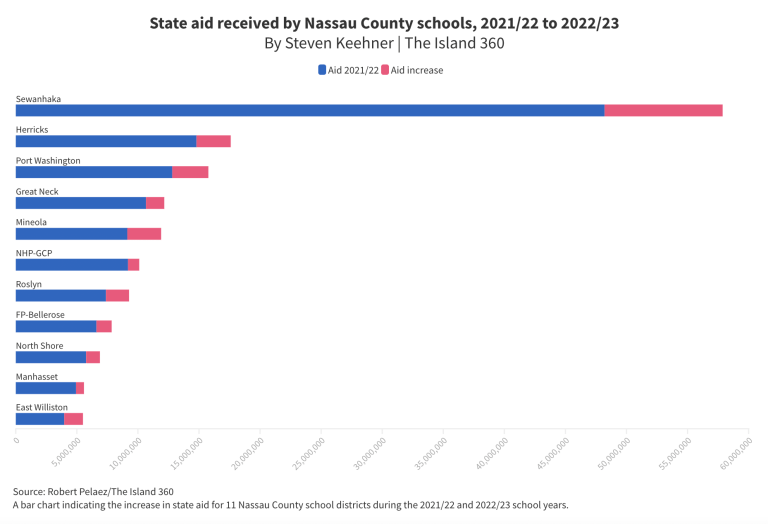
This is the third in a series on North Shore school districts
The figures were selected from the state Legislature and compared with demographic and enrollment figures from the state’s Education Department.
The average 2022-23 state aid for the 11 school districts was $14.3 million, with the Sewanhaka School District receiving the most at nearly $57.9 million and the East Williston School District having the least at $5.5 million.
The boost in state aid for the 11 public school districts on the North Shore is part of a record $457 million in extra financial aid for all Long Island public school districts included in the state’s budget, which was approved in April. The cumulative rise in the 11 school districts is larger in percentage terms than the cumulative 16.52% increase for all Nassau County school districts.
The average amount of 2022-23 state aid increases for the 11 public school districts throughout the North Shore of Nassau County is more than 21%, a figure higher than the increases for the four districts whose minority enrollment is higher than their white enrollment, according to an analysis conducted by Blank Slate Media.
The four school districts whose 2020-21 minority enrollment was greater than their white enrollment are Great Neck, Herricks, New Hyde Park-Garden City Park and Sewanhaka. Minority enrollment is comprised of black, Hispanic or Latino, Asian and other non-white students, according to the state’s Education Department.
Great Neck’s white enrollment made up 42.8% of the district, according to the figures, while its cumulative minority enrollment made up 54.4%. Herricks’ white enrollment was 22.5% while its minority enrollment made up 75.9%, according to the figures.
New Hyde Park-Garden City Park’s minority enrollment made up 75.6% of the district, while its white enrollment made up nearly 22%. Sewanhaka had minority enrollment of 68%, while white students made up 30.6% of the district, according to statistics.
Despite Sewanhaka leading the analyzed districts in total state aid, it also led the districts in total enrollment with 8,003 students. The $9.6 million, or 20%, increase Sewnahaka is scheduled to receive in state aid from the 2021-22 school year was only the fifth-highest throughout the analyzed districts. Great Neck is set to receive more than $12 million in state aid for the 2022-23 school year, a 14% increase from the previous year, which is the third-lowest increase among the districts.
Herricks is set to receive nearly $17.6 million for the 2022-23 school year, nearly a 19% increase from last year, also in the bottom half of percentage increases among analyzed districts. New Hyde Park-Garden City Park, which had the second-lowest increase in state aid among the analyzed school districts, is also set to receive the lowest percentage increase in state aid of nearly 10%, or $6.9 million, for the 2022-23 school year.
Gov. Kathy Hochul said the $31.5 billion statewide package “will broaden access to opportunity in New York and build the education system of the future,” according to a statement she issued.
“The opportunity to pursue a quality education is the silver bullet for so many New Yorkers,” Hochul said. “With this budget we are going to unleash the power of higher education to lift up the people of our state by investing in our institutions and our teachers.”
While Hochul’s goal to provide New Yorkers with “quality education” is something parents and guardians should be pleased to hear, ERASE Racism—a regional civil rights organization—released a report finding unequal resources for school districts with prominent minority enrollment throughout Long Island. The report found that there is one guidance counselor for every 500 students in majority black and Hispanic school districts compared to one per 356 students in districts with predominantly white enrollment.
“We sought instead to understand how equitably educational resources are allocated across school districts,” ERASE Racism President Elaine Gross said. “We found that the differences in resource allocation are stark, depending on a district’s racial composition. This must be addressed by state, county, and local authorities.”
In order to bridge the gap in disparities between districts with predominantly minority and white enrollments, the organization recommended the state Legislature prioritize equitable funding, resource sharing and racially integrated learning environments.
Alan Singer, a professor of education and history at Hofstra University, said districts with large numbers of English Language Learners, such as Hempstead and Roosevelt, require additional funds. While New York’s education is “overwhelmingly” financed by property taxes, Singer said, the federal government does not mandate schools be funded that way.
“In 1995, New York state took over Roosevelt and pumped some money in, but it didn’t really change the quality of education in the district,” Singer said. “What i argue is why not consolidate districts. I argued that the state wasn’t bailing out Roosevelt, it was bailing out Bellemore-Merrick to maintain a separate district.”
Singer said it is hard to determine what state aid is appropriate for school districts to ensure that quality education is being provided to everyone because some school districts have certain students with specific needs. A child’s financial situation should not determine the type of education they receive, Singer said.
“Should your good fortune of getting the right parents in the right neighborhood determine your future?” Singer asked “To me, that’s not the kind of Long Island we want to have. It shouldn’t be a lottery based on birth.”






